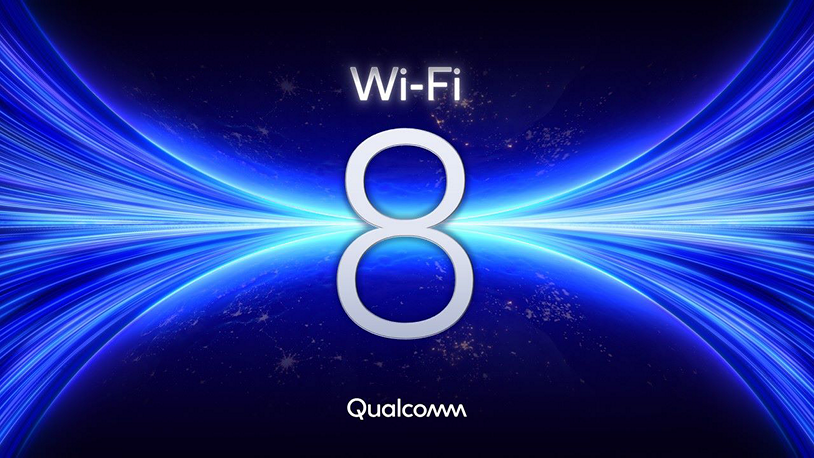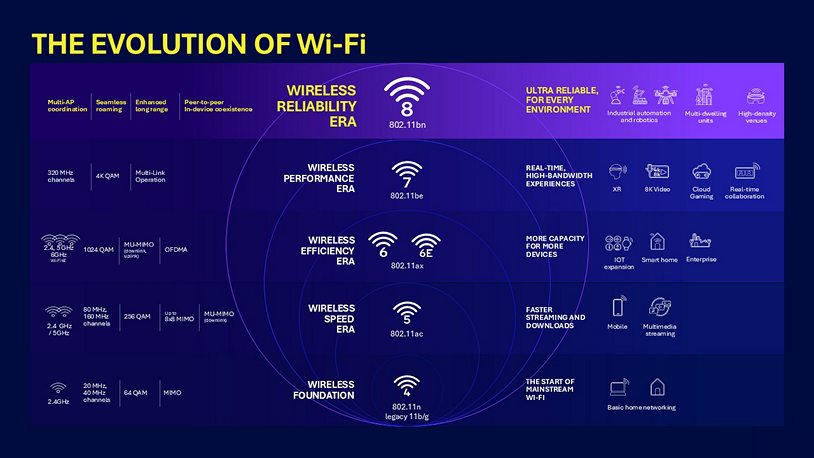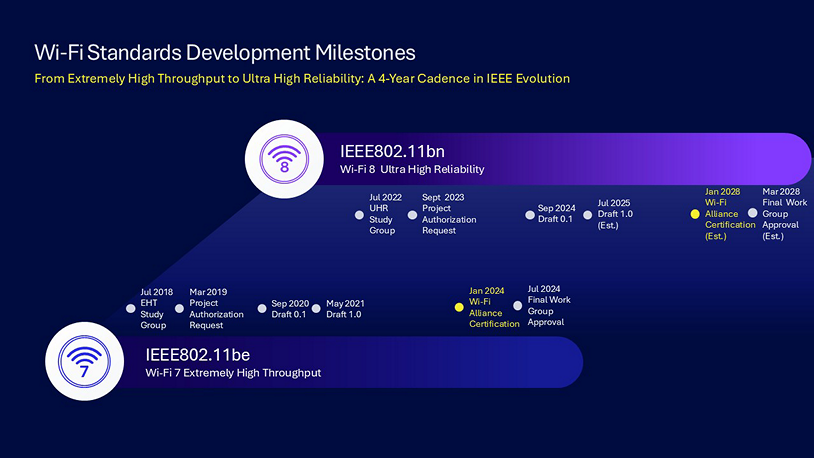Next-gen Wi-Fi 8 focuses on reliability instead of speed — "Ultra High Reliability" initiative boosts performance, lowers latency and packet loss in challenging conditions

We already know that the next-generation Wi-Fi 8 (IEEE 802.11bn) specification is not meant to improve performance, but rather to boost reliability of wireless connections as they become even more ubiquitous. Since improving reliability is a pretty vague description, the IEEE has issued a scope document that quantitatively defines these enhancements. According to a new post by Qualcomm (which is a contributor to the standard), the IEEE wants Wi-Fi 8 devices to offer a 25% improvement across a number of metrics, under the umbrella of Ultra High Reliability, or UHR.
Just like Wi-Fi 7, Wi-Fi 8 is set to offer a peak physical layer (PHY) rate of up to 23 GT/s, though it remains to be seen whether such rate will be achievable in real-world conditions. The UHR goals in Wi-Fi 8 aim to deliver a 25% increase in real-world data throughput specifically under challenging signal conditions.
UHR means devices operating at the edge of network coverage, or in areas with interference or weak signals, can still achieve significantly better performance compared to Wi-Fi 7 (i.e., move data fast even when signal quality is not ideal).
The standard also targets a 25% reduction in latency at the 95th percentile — not just average latency — to improve worst-case responsiveness, which is critical for time-sensitive applications like augmented reality, industrial automation, and AI-based systems that depend on fast and predictable communication.
Finally, Wi-Fi 8 is designed to achieve 25% fewer dropped packets, especially when users or devices move between access points. As part of the overall Wi-Fi 8 standard, this goal is meant to support seamless roaming and uninterrupted connectivity, which promises to make it far more suitable for environments where mobility is common, such as enterprise campuses, public venues, and production environments, such as plants.
At a broad technical level, Wi-Fi 8 (802.11bn) shares much of the same foundation as Wi-Fi 7 (802.11be): it operates across the 2, 4, 5, and 6 GHz frequency bands, employs 4096-QAM modulation, supports up to eight spatial streams, utilizes MU-MIMO and multi-user OFDMA, and maintains a maximum channel width of 320 MHz.
To achieve its goals, the Wi-Fi 8 specification is set to support a number of key new features, including Coordinated Spatial Reuse (Co-SR), Coordinated Beamforming (Co-BF), Dynamic Sub-Channel Operation (DSO), and enhanced Modulation Coding Scheme (MCS).
Get Tom's Hardware's best news and in-depth reviews, straight to your inbox.
If the IEEE's guidance bears out, Wi-Fi 8 could significantly benefit applications that require reliable, low-latency connectivity, particularly in environments with congestion, interference, or mobility. In enterprise and industrial settings, it could support mission-critical systems like autonomous guided vehicles, collaborative robots, and factory automation to ensure seamless operation even during transitions between access points.
In public venues such as airports, malls, or stadiums, Wi-Fi 8 could improve workloads like AR navigation, live video sharing, real-time translation, and critical systems like surveillance and emergency communication. As for the home, users might experience higher performance and more reliable connections in dense residential buildings.
Wi-Fi 8 (IEEE 802.11bn) is expected to reach draft 1.0 status any day now, which will define its core features and enable makers of equipment to implement them. Actual Wi-Fi Alliance certification is planned for January 2028, enabling product interoperability testing and development. Final approval by the IEEE 802.11 Working Group is scheduled for March 2028, which is when the standard will be completed.
Follow Tom's Hardware on Google News to get our up-to-date news, analysis, and reviews in your feeds. Make sure to click the Follow button.

Anton Shilov is a contributing writer at Tom’s Hardware. Over the past couple of decades, he has covered everything from CPUs and GPUs to supercomputers and from modern process technologies and latest fab tools to high-tech industry trends.
-
BryanFRitt No mention of WiFi 7 becoming an officially published 2025-07-22?Reply
https://grouper.ieee.org/groups/802/11/Reports/802.11_Timelines.htm -
heffeque Nice!Reply
I'm happy with WiFi 7 on MLO, so I have no doubt that WiFi 8 will be great for high noise environments. -
HideOut WiFi 7's real problem is there is no standard. It can be WiFi 7 and still not have 6GhZ. Its a joke. Until the standard is an actual standard they are just posting uupdates of wh at they can make if you pay enough.Reply -
Alvar "Miles" Udell Standardized in 2028, starts appearing in 2029, widespread in new devices in 2032, and widespread in the userbase in 2035 in time for Wi-Fi 9 no doubt.Reply -
usertests Reply
There are plenty of standards with optional bits, Bluetooth is far worse.HideOut said:WiFi 7's real problem is there is no standard. It can be WiFi 7 and still not have 6GhZ.
Congress was recently trying to legislate the 6 GHz band away from Wi-Fi, so there's that.
https://arstechnica.com/tech-policy/2025/06/senate-gop-budget-bill-has-little-noticed-provision-that-could-hurt-your-wi-fi/ -
LCT_ This is stupid, latency is performance. Once you reach a certain level of bandwidth, it's the most important metric of performance.Reply
This is why you don't game on wireless, latency and jitter. A gig connection with 150-200ms first hop latency is still a poor connection IMO. Fight me. -
M0rtis Reply
Yeah, 6Ghz Wifi is currently "under review" i.e. currently banned, in India because telecom operators lobbied against it saying that modem manufacturers need to bid for operations in the 6Ghz spectrum because its unfair for them to compete with.usertests said:There are plenty of standards with optional bits, Bluetooth is far worse.
Congress was recently trying to legislate the 6 GHz band away from Wi-Fi, so there's that.
https://arstechnica.com/tech-policy/2025/06/senate-gop-budget-bill-has-little-noticed-provision-that-could-hurt-your-wi-fi/ -
kretkris I don't care about all these geek's staff and descriptions . STILL LOOKING FOR A DECENT ROUTER , WITH RANGE OF 300 meters ( 900 feet ) .Reply -
usertests Reply
That's a niche. You probably need something like HaLow.kretkris said:I don't care about all these geek's staff and descriptions . STILL LOOKING FOR A DECENT ROUTER , WITH RANGE OF 300 meters ( 900 feet ) . -
bill001g Reply
Does it really matter if you find a router that could go 900 feet. Your end device is half the connection. If it also can not go 900 feet then it all doesn't matter.kretkris said:I don't care about all these geek's staff and descriptions . STILL LOOKING FOR A DECENT ROUTER , WITH RANGE OF 300 meters ( 900 feet ) .
The main reason nothing goes that distance is because all wifi no matter what silly number they put on it is still limited by the transmit power allowed and that has not changed since the beginning of wifi. All they have been doing with the newer wifi is changing the way the encode the data into the radio signals. The distance the radio signals go has not changed. This is purely a function of output power and how much signal is absorbed by everything between including the air.

